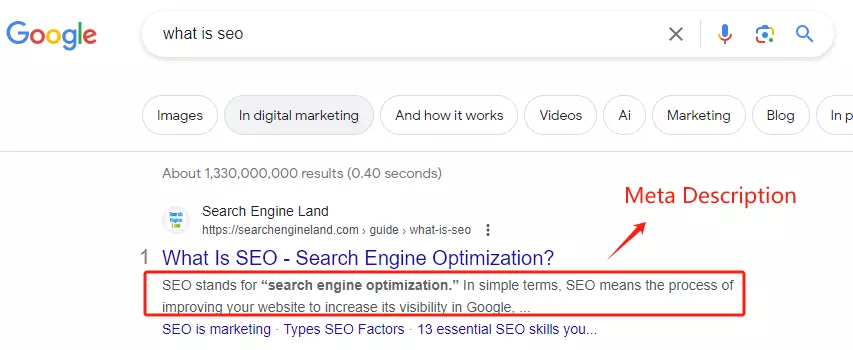
In the vast landscape of digital marketing and search engine optimization (SEO), meta descriptions play a crucial yet often overlooked role. But what is a meta description?
A meta description is a summary of the content of a web page. It is an HTML attribute that provides search engines and users with a concise overview of what the page is about.
In this guide, we'll delve deep into meta descriptions, exploring what they are, why they matter, and best practices for optimizing them to boost your SEO ranking.
What is a Meta Description?
A meta description refers to the brief snippet of information beneath the blue link in a search result. Its primary function is to provide a concise overview of the page's content to the searcher.
In the description, any words that match the search term are typically bolded to catch the searcher's attention. Ultimately, the objective is to persuade and convince the searcher to click through to your website.
Here is an example of a meta description as it would appear on a search engine results page (SERP):

Why are Meta Descriptions Important?
Meta descriptions play a crucial role as they inform Google about the content of your webpage. By effectively communicating the essence of your content through meta descriptions, you enhance the likelihood of Google accurately ranking your page to address user search queries.
Failure to include a meta description prompts Google to generate a snippet from the initial paragraph of your page, potentially bolding relevant search keywords. While this isn't detrimental, omitting a meta description denies the opportunity to tailor the message conveyed to browsers.
What Makes a Good Meta Description?
Writing an impactful meta description is essential, but it requires optimization for both search engines and users. Thus, mastering the art of writing a meta-description entails grasping its fundamental elements and characteristics.
Optimal Length
Adhering to prescribed length guidelines is crucial for meta descriptions. Overextending them risks truncation in search results, disrupting readability.
Aim for a concise meta description spanning 155-160 characters to ensure completeness without being cut off mid-sentence. Despite brevity, prioritize crafting compelling copy that entices users to explore your page further.
Call to Action (CTA)
Meta descriptions serve as persuasive prompts for users to click on your link, necessitating a clear directive on what action to take next. Incorporate a strong CTA alongside a descriptive overview of your page's content to incentivize clicks and engage the audience effectively.
Target keywords
Given your endeavor to enhance meta descriptions, it's presumed you've already embarked on optimizing other on-page content and targeting specific keywords to bolster SERP rankings.
Integrating your target keyword into the meta description aids search engines in understanding your page's intent while increasing click-through rates. Aligning with users' search queries enhances the likelihood of them selecting links that resonate with their interests.
How to Write Meta Descriptions? Easy Tips

Now that you've grasped the pivotal 3 components of a meta description and comprehended their significance for SEO and website traffic, it's imperative to delve into the art of composing them effectively.
Here are some insights on crafting compelling meta descriptions to boost your Click-Through Rate (CTR).
Be clear
A meta description serves as a succinct preview of your page's content. Any disparity between the description and actual content heightens the risk of a higher bounce rate, impacting website conversion rates. While bounce rate doesn't directly influence rankings, it reflects users clicking a result but departing without exploring further, which undermines site engagement.
Misleading or inaccurate descriptions merely to attract more visitors prove counterproductive, as such visitors are likely to leave upon finding incongruity between the meta description and page content.
Consider User Intent
Search engines factor in user intent when presenting search results, underscoring the need for meta descriptions to align with why users should choose your link. Tailoring your meta description to cater to different user types and their specific intents is crucial.
For instance, if a user searches for web development tips, adapting the language in your meta description to suit the technical proficiency level—be it beginner, intermediate, or advanced—can significantly influence engagement.
Prevent Duplicates
While it may be tempting to recycle meta descriptions for similar pages to save time, uniqueness is paramount. Search engines leverage meta descriptions to gauge content relevance and match user intent accurately.
Failure to ensure uniqueness can lead search engines to extract other page content to fulfill user intent, potentially diminishing visibility.
Avoid Keyword Stuffing
The outdated tactic of keyword stuffing has been recognized by search engines as detrimental to user experience.
Instead of cramming keywords into your meta description, aim for natural incorporation of one relevant keyword to effectively encapsulate the essence of the web page.
Conclusion on What is a Meta Description
Write a captivating meta description to captivate your audience. Ensure your website boasts an enticing meta description that convinces individuals to opt for your content initially.
Indeed, if your web pages are designed to be beneficial and valuable to users, the description should reflect the same level of usefulness and value.

